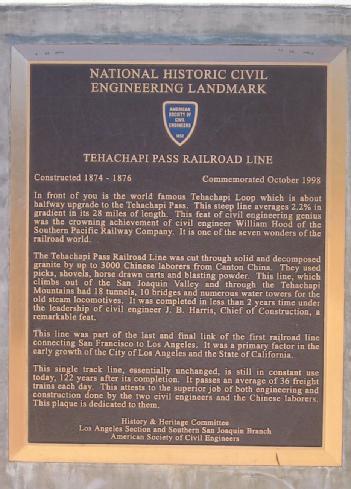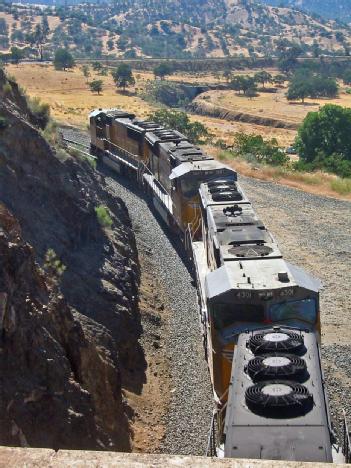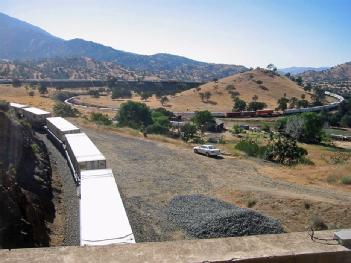
Tehachapi Loop Overlook Site |
93561 Tehachapi, CA, United States of America (USA) (California) |
|
| Address |
26800-26842 Woodford-Tehachapi Rd
|
| Floor area | unfortunately not known yet |
Railway
- Historic Engineering Landmarks
|
Opening times
|
24 hours each day | ||||
|
Status from 02/2024
|
Free entry. | ||||
| Contact |
|
||||
| Homepage | |||||
| Location / Directions |
The Tehachapi Loop is a 0.73 miles (1.17 km) long spiral, or helix, on the Union Pacific Railroad Mojave Subdivision through Tehachapi Pass, of the Tehachapi Mountains in Kern County, south-central California. The line connects Bakersfield and the San Joaquin Valley to Mojave in the Mojave Desert. |
| Description | From Wikipedia, the free encyclopedia: Rising at a steady two percent grade, the track gains 77 feet (23 m) in elevation in the Loop. Any train more than 4,000 feet (1,200 m) long passes over itself going around the loop. At the bottom of the loop, the track passes through Tunnel 9, the ninth tunnel built as the railroad worked from Bakersfield. The line averages approximately 40 trains each day. Due to its frequent trains and scenic setting, the Tehachapi Loop is popular with railfans.[citation needed] In 1998 it was named a National Historic Civil Engineering Landmark and is designated as California Historical Landmark #508. History One of the engineering feats of its day, the Loop was built by Southern Pacific Railroad to ease the grade over Tehachapi Pass. Construction began in 1874, and the line opened in 1876. Contributors to the project's construction include Arthur De Wint Foote and the project's chief engineer, William Hood. The siding on the loop is known as Walong after Southern Pacific District Roadmaster W. A. Long. The project was constructed under the leadership of Southern Pacific’s civil engineers, James R. Strobridge and William Hood, using a predominantly Chinese labor force. The Tehachapi Loop took under two years to complete, featuring 18 tunnels, 10 bridges, and numerous water towers for the steam locomotives. Between 1875-76 about 3,000 Chinese workers equipped with little more than hand tools, picks, shovels, horse drawn carts and blasting powder cut through solid and decomposed granite to create the helix-shaped 0.73 mile loop with grades averaging about 2.2 percent and an elevation gain of 77 feet. A large white cross, "The Cross at the Loop", stands atop the hill in the center of the loop in memory of two Southern Pacific Railroad employees killed on May 12, 1989, in a train derailment in San Bernardino, California. A railroad museum stands in the nearby town of Tehachapi. Operations The Loop became the property of the Union Pacific in 1996, when the Union Pacific and Southern Pacific systems merged. Trains of the BNSF Railway also use the loop under trackage rights. Southern Pacific and Union Pacific have long barred passenger service over the line due to capacity limits, which prevents Amtrak's San Joaquin train from serving Los Angeles (passengers instead must board Amtrak Thruway Motorcoaches to connect from Bakersfield to Los Angeles). This has been the case since the creation of Amtrak in 1971. An exception is made for the Coast Starlight, which uses the line as a detour if its normal route is closed. |
[dsp_museum_detail.cfm]
| Data Compliance | More Information |
 gmail.com
gmail.com 

